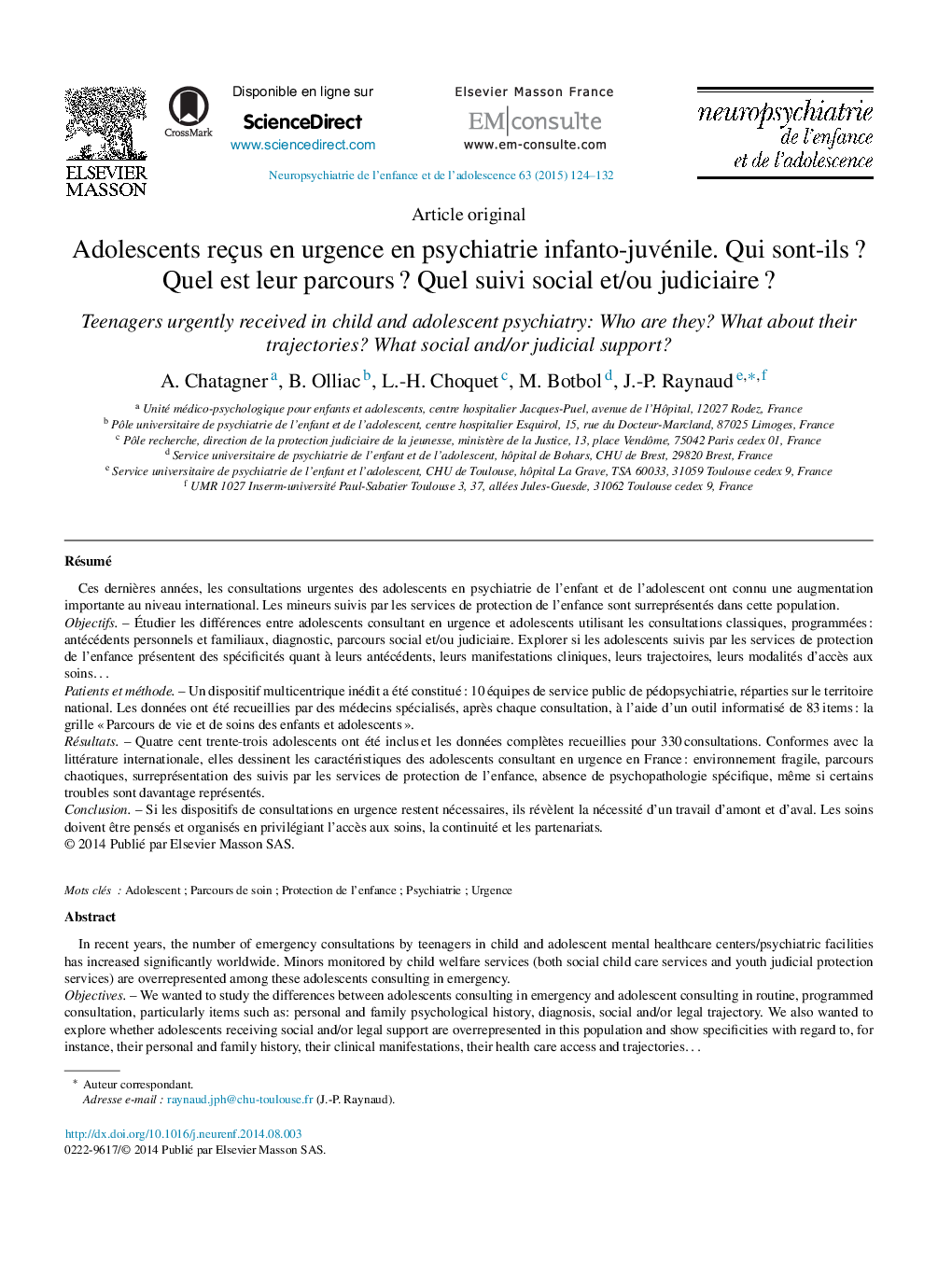| کد مقاله | کد نشریه | سال انتشار | مقاله انگلیسی | نسخه تمام متن |
|---|---|---|---|---|
| 943753 | 925556 | 2015 | 9 صفحه PDF | دانلود رایگان |

RésuméCes dernières années, les consultations urgentes des adolescents en psychiatrie de l’enfant et de l’adolescent ont connu une augmentation importante au niveau international. Les mineurs suivis par les services de protection de l’enfance sont surreprésentés dans cette population.ObjectifsÉtudier les différences entre adolescents consultant en urgence et adolescents utilisant les consultations classiques, programmées : antécédents personnels et familiaux, diagnostic, parcours social et/ou judiciaire. Explorer si les adolescents suivis par les services de protection de l’enfance présentent des spécificités quant à leurs antécédents, leurs manifestations cliniques, leurs trajectoires, leurs modalités d’accès aux soins…Patients et méthodeUn dispositif multicentrique inédit a été constitué : 10 équipes de service public de pédopsychiatrie, réparties sur le territoire national. Les données ont été recueillies par des médecins spécialisés, après chaque consultation, à l’aide d’un outil informatisé de 83 items : la grille « Parcours de vie et de soins des enfants et adolescents ».RésultatsQuatre cent trente-trois adolescents ont été inclus et les données complètes recueillies pour 330 consultations. Conformes avec la littérature internationale, elles dessinent les caractéristiques des adolescents consultant en urgence en France : environnement fragile, parcours chaotiques, surreprésentation des suivis par les services de protection de l’enfance, absence de psychopathologie spécifique, même si certains troubles sont davantage représentés.ConclusionSi les dispositifs de consultations en urgence restent nécessaires, ils révèlent la nécessité d’un travail d’amont et d’aval. Les soins doivent être pensés et organisés en privilégiant l’accès aux soins, la continuité et les partenariats.
In recent years, the number of emergency consultations by teenagers in child and adolescent mental healthcare centers/psychiatric facilities has increased significantly worldwide. Minors monitored by child welfare services (both social child care services and youth judicial protection services) are overrepresented among these adolescents consulting in emergency.ObjectivesWe wanted to study the differences between adolescents consulting in emergency and adolescent consulting in routine, programmed consultation, particularly items such as: personal and family psychological history, diagnosis, social and/or legal trajectory. We also wanted to explore whether adolescents receiving social and/or legal support are overrepresented in this population and show specificities with regard to, for instance, their personal and family history, their clinical manifestations, their health care access and trajectories…Patients and methodsAn unprecedented national multicenter scheme was set up, consisting of 10 teams of public child and adolescent psychiatric departments, well distributed on the French territory and selected on a voluntary basis. During 4 months, after each consultation, trained physicians collected the data used in this study, by filling out a computerized grid, titled “Life course and treatment of children and adolescents”, which includes 83 items.ResultsFour hundred and thirty-three adolescents were included, and we collected complete data for 330 consultations. The data outline the characteristics of adolescents using the psychiatric emergency services in France, which are in keeping with the international literature. They highlight the fragility of their environment, and how they are much more subject to a chaotic trajectory. We were able to identify the overrepresentation of adolescents followed by child welfare services (both social and judicial), which appear as a relevant indicator of turbulences in the lives of these teenagers. Indeed, they are often a consequence of failing early interactions or later abuse. The youth having the most issues, and especially with the legal system, are those having, in their history or currently, the more psychopathological disorders. In a second phase, focusing more specifically on adolescents who receive social and/or judicial support, we showed that they were mainly experiencing externalizing problems (F90 to F92 in ICD-10), which require continuity and longtime care. Numerous and distressing separations in the past of these teenagers are at play once again in the way they chose to use emergency consultation, instead of programmed ones. This consistency, so much needed, can be achieved through the establishment of working partnerships between the different professionals in charge of these adolescents, as an answer to the internal and external chaos they experience.ConclusionThe emergency consultations are useful, but they are also indicative of the need to reinforce care upstream for these adolescents. Their therapeutic management requires an organization designed to tackle their chaotic trajectory: continuity and institutional cooperation are the cornerstones of a specific treatment. A prospective study could explore more precisely the nature of the supports which are offered afterward to these adolescents and evaluate their efficiency.
Journal: Neuropsychiatrie de l'Enfance et de l'Adolescence - Volume 63, Issue 2, March 2015, Pages 124–132